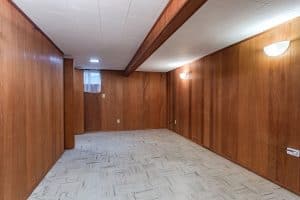Basement stair walls are what makes your basements accessible because this helps support your basement stairs. Have you ever wondered though if the walls supporting your stairs are load-bearing? In this article, we have done the research and we will answer the exact question, so stick until the end to find out.
To tell if your basement stair walls are load-bearing, look if it is perpendicular to your joists; if the joists are resting directly on top of your wall it is a load-bearing wall. But if another structure like a beam or another wall is also located along your basement stair walls, then it probably is not.
Finish reading as we continue to dive into more details about basement stair walls and other related topics that can answer your basement-connected questions.

Can a basement stair wall be load-bearing?
Basement stair walls can definitely be load-bearing especially since they are located in the basement that is under the house, so it is common for them to receive the weight above from the house.
As we mentioned above, you can identify yourself if walls are load-bearing just by simply looking if something is resting on top of it. But if you are still not sure about your assessment, ask someone who knows (preferably an engineer) to check it; this would be best.

Identifying if your basement stair wall or any other wall is load-bearing is important so that if you decide to make any changes or renovate, you will know which walls are not to be taken down. Load-bearing walls are integral in supporting the house's weight.
If you are planning to open your staircase to add more breathing space and aesthetics to your basement, a thorough inspection is recommended to see you if will not be compromising a load-bearing stair wall. This is for the overall safety of the house.
Have you ever wondered how wide should your stairs be? Check this previous article that we wrote on how wide stairs should be to help you if you are planning to remodel or add stairs in your homes.
What happens if you knock down a load-bearing wall?
Knocking down a load-bearing wall without the intention of replacing it with a beam can lead to severe structural damage to your house. Load-bearing walls serve as part of the foundations that keep your house upright and carry the weight that is on top of it.
If a load-bearing wall is under a floor, it is the one receiving the weight of that floor which then transfers it to the ground, if you were to break down the wall, chances are the floor that is relying on support from that wall might collapse and can be a hazard to your home.
While it is possible to remove a load-bearing wall, we recommend not to do this type of project yourself. It is best to seek for professional contractors to do this as they will do a more comprehensive method and assessment on whether or not it is actually safe.
Professionals also know where to place the replacement load-bearing structure to maintain the integrity and sturdiness of the house. Tearing down a load-bearing wall requires proper planning and equipment. Licensed contractors and engineers are experts in this field.
How are basement stairs supported?
Basement stairs are supported by what we call stringers, these are the side of the stairs where treads and risers are secured. Most staircases have two stringers, one that is on the wall and one that is on the outer part. Some stringers are not mounted on a wall because they are not stairwells.
But this will all depend on the different designs of stairs. Not all stairs are the same, some are more complicated than others. With different ways of building stairs being implored today, some support systems such as stringers might appear differently on other designs.
With this, having the right design of stairs in your basement is important, because if it is not suitable it might make accessing your basement harder and the support might not be correctly mounted because of the incompatibility in design.
Having your stairs properly supported is important as you will be putting weight on every tread. Having your stairs checked regularly is one way of avoiding accidents especially if the stairs that you have are old and made of wood.
Stairs maintenance
Checking the stringers for damage can avoid accidents. Look for deterioration. If some parts of the stairs need to be replaced, replace them immediately and be aware of termite infestation if it is made out of wood.
Water can damage your stairs, so check for any leaks that may pass through your stairs, clean up spills as they are also slippery and hazardous to unsuspecting users.
If you are moving into a house with basement stairs it is best to have it checked out first and see if it is still safe to use. Some stairs get brittle through time while others, because of less wear and tear are still sturdy so it is best to know which is which.
Planning on installing insulation under your basement stairs? We have an article for you: "How To Insulate Basement Stairs."
Can I move my basement stairs?

Yes of course you can. In fact, it is a very common practice to move stairs as this dramatically changes the layout of your interior. But before doing so, you must first identify if your basement stair walls are load-bearing.
By referencing the guide above, if you have already identified if your stair walls are load-bearing or not, the next step is planning. If your stair walls are non-load-bearing, it is easier to relocate as you can do it by yourself.
If you have to work with load-bearing stair walls you will need a contractor or a licensed engineer to do so for you. As we mentioned earlier, any job regarding load-bearing walls should be handled by professionals.

This is only possible if you know your house very well, so we suggest that before you do any major makeover in your house, study first your floor plan and structure to have a better understanding of how your house is built and base your designs on it.
If you opt to go for a contractor to do it for you, you can expect a cost of anywhere between $1,100 to $3,200, with the majority paying around $2,100 for a 12-step wooden staircase. These figures are the national average, prices may be lower or higher depending on the type of staircase.
By choosing to pay for professionals, you can expect a faster and smoother process with more clean work done for you. just make sure to hire trusted contractors to avoid any inconvenience.
In Summary

In conclusion, not all basement stair walls are load-bearing, some are just adjacent to a load-bearing structure. If your stair wall is indeed load-bearing, any renovations or projects that you are planning should be done by experts as to not compromise the overall integrity of your house.



![A house under construction made from cinderblocks, Are Cinder Block Walls Soundproof [Including 6 Methods for Pre & Post Construction]](https://basementing.com/wp-content/uploads/2022/01/A-house-under-construction-made-from-cinderblocks-300x200.jpg)